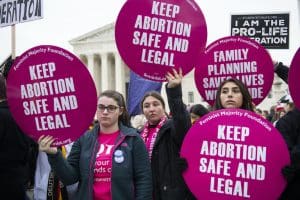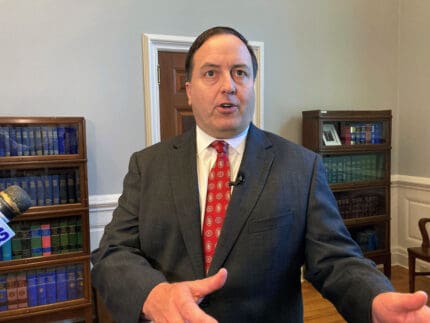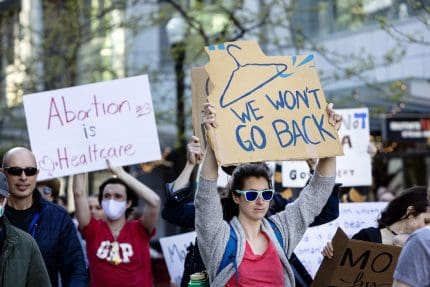Coronavirus abortion bans may be over — but they've caused lasting damage
Substantial barriers remain in states across the country.

At the start of the coronavirus pandemic, several states tried to use the crisis to ban abortion. The situation in Texas was particularly complicated, with the legality of the procedure changing several times within just a few weeks.
Today, none of those bans remain in effect, but the confusion lingers. Additionally, it’s only now becoming clear how many people seeking abortions were turned away from clinics during those bans.
The nonprofit communications group Progress Texas recently interviewed Texas providers to learn more about those delays. The director of Planned Parenthood Houston, Dr. Bhavik Kumar, said that their clinic canceled hundreds of appointments over the course of the ban.
Further, because the legal status of abortion kept changing, the clinic opened and closed eight times in the months of March and April. Kumar says that meant there was “certainly a backlog” of patients needing abortions.
Similarly, Amy Hagstrom Miller, president of Whole Women’s Health, which has multiple clinics in Texas, said that 5% of their patients traveled elsewhere to get an abortion during the bans in Texas. However, travel, Miller noted, is out of the reach of many.
“Most people, even in normal times, simply cannot travel hundreds of miles for an abortion – taking off work, arranging child care, arranging transportation and hotels.” Hagstrom Miller said, noting the situation is “even more dire in the middle of a pandemic.”
Studies have shown that the increased costs associated with travel create a substantial barrier to abortion care. Those costs can take the form of lost wages for multiple work days, transportation, hotel stays, and child care. As a person’s pregnancy progresses, the cost of obtaining an abortion increases, while the number of possible providers decreases.
When abortion suddenly becomes unavailable in an entire state, as was the case in Texas, it doesn’t just affect clinics there. Clinics in neighboring states that continued to provide abortions saw spikes in numbers of out-of-state patients as they worked to absorb the overflow.
In the early part of March, Trust Women, a clinic in Oklahoma, initially received patients from states that had imposed bans earlier in the pandemic. However, on March 27, Oklahoma’s Republican governor declared all abortion in the state banned due to the pandemic, and Trust Women was forced to cancel 164 appointments. The staffers at the Oklahoma clinic then worked to place people for abortions in Arkansas—which later banned the procedure as well—and Kansas.
Even when abortion access returned to Oklahoma, substantial barriers remained. As in Arkansas, Oklahoma required anyone receiving a procedural abortion to first have a negative coronavirus test. However, virus testing kits aren’t widely available, and test results aren’t provided very swiftly. As of June 18, Oklahoma had only tested 276,000 people, or roughly 7% of its population. The state lifted its requirement for coronavirus testing prior to abortion earlier this month.
Researchers for the Guttmacher Institute, which tracks abortion policies and restrictions, note that it is too soon to fully measure the impact of these bans. However, by reviewing prior attempts to ban or severely limit access to abortion, the researchers contend the costs of additional travel are likely to be a barrier to care. Those increased costs could be expected to “[push] individuals past the gestational limits for an abortion in many states and, ultimately, make abortion inaccessible.”
Given the numbers from Texas and Oklahoma alone, it’s likely that several hundred people at best ended up receiving an abortion later in pregnancy and at worst were unable to obtain one at all. Further, the Guttmacher researchers posit, clinics may still not be running at full capacity during the pandemic. Social distancing may require clinics to reduce their caseloads, and staff may be infected or quarantined. That may make it impossible to work through a potential backlog of patients who were unable to obtain abortion care during the pandemic.
The COVID-19 bans have all expired, but they’ll continue to affect people’s lives for a long time.
Published with permission of The American Independent Foundation.
Recommended

Ohio doctors fear effects of emergency abortion care case set to go before U.S. Supreme Court
A federal law that allows emergency departments to treat patients without regard to their ability to pay will be under U.S. Supreme Court scrutiny this week, and Ohio doctors are concerned about the case’s local impact on emergency abortion care.
By Susan Tebben, Ohio Capital Journal - April 23, 2024
House GOP votes to end flu, whooping cough vaccine rules for foster and adoptive families
A bill to eliminate flu and whooping cough vaccine requirements for adoptive and foster families caring for babies and medically fragile kids is heading to the governor’s desk.
By Anita Wadhwani, Tennessee Lookout - March 26, 2024
U.S. House Speaker Johnson says IVF should be protected — just not by Congress
U.S. House Speaker Mike Johnson said Thursday that it’s up to states and not Congress to preserve access to in vitro fertilization, weighing in on a growing national debate and campaign issue.
By Jennifer Shutt, States Newsroom - March 14, 2024








































































